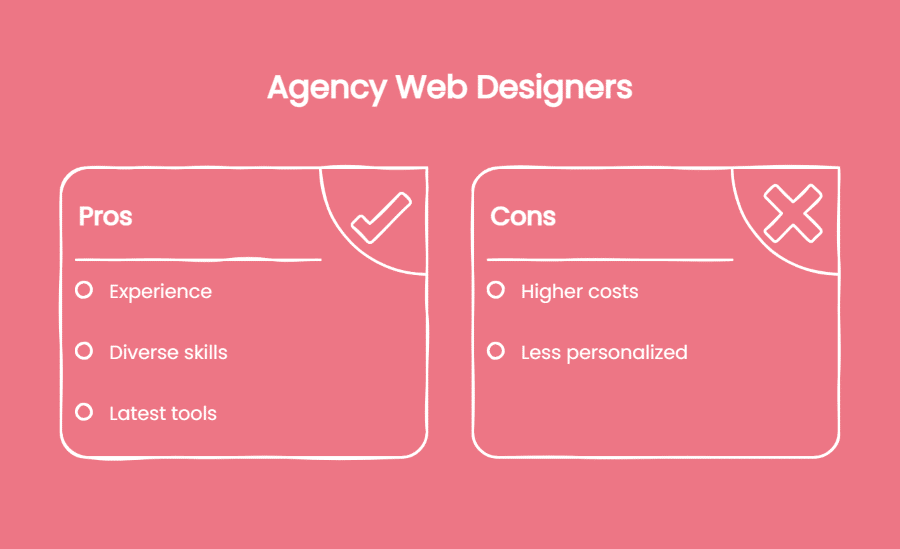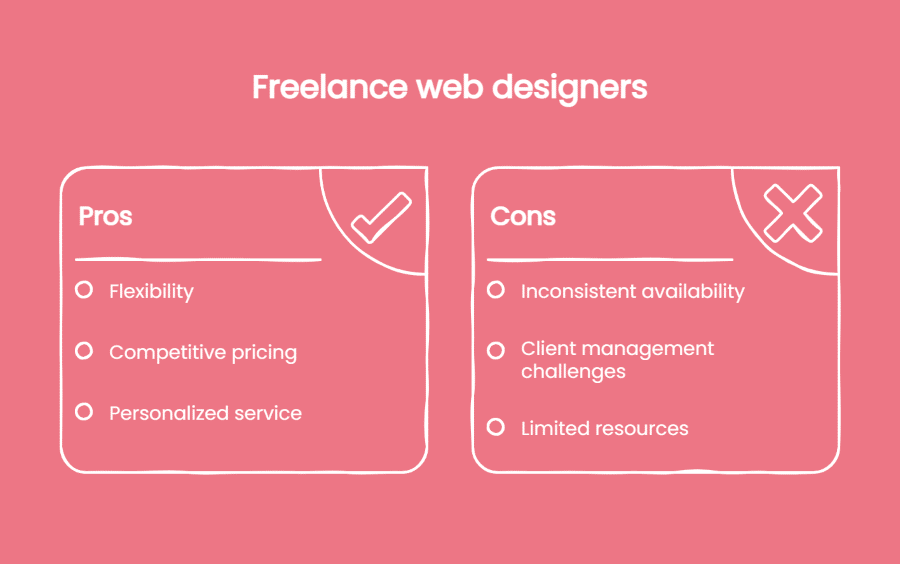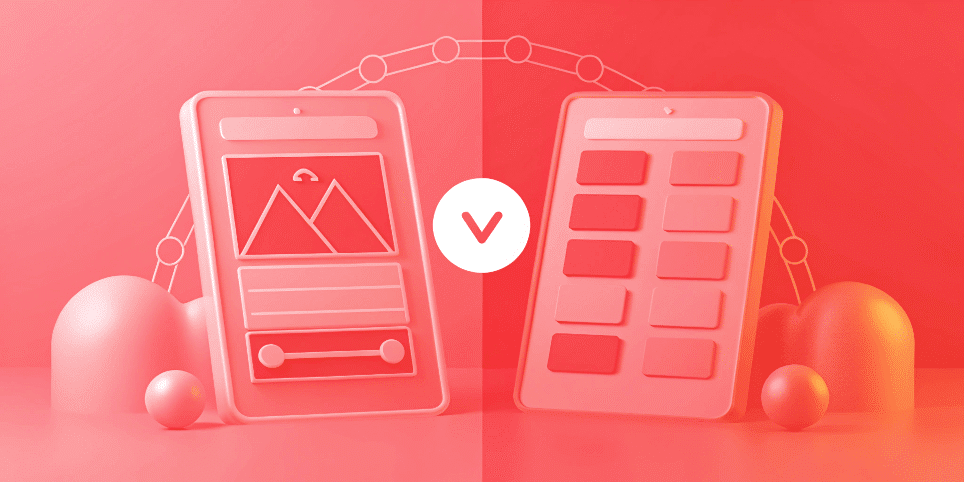TL;DR: Choosing between a web design agency and a freelancer in Australia largely depends on your project scope, budget, and support requirements.
Agencies offer teams of specialists, faster delivery, and stronger long-term support but come at higher costs, typically $5,000–$50,000+.
Freelancers provide more direct communication, flexibility, and lower pricing from around $2,000, though projects can take longer, and reliability may vary. This guide explains the differences, compares costs, and includes a practical framework to help you decide.
Finding the right partner for your website can feel like a bigger decision than the website itself.
Search for “web design Australia” and you’ll be flooded with agency options, each promising polished design and proven results. Freelancers are just as common on platforms like LinkedIn, Upwork, and Fiverr — but with so many profiles to sift through, you still have to carefully work out who’s right for the job.
Both paths can lead to a professional website, but the costs, timelines, and level of support differ greatly. This guide breaks down the pros and cons of each and offers a simple framework to help you choose with confidence.
Agency vs Freelancer: What’s the Difference?
At its core, the decision comes down to scale.
A web design agency works like an outsourced creative department. You’re not hiring one person, but a team — designers, developers, project managers, and strategists who collaborate to deliver your site. This structure gives agencies the ability to run larger, more complex projects and keep them moving even when timelines are tight.
A freelance website designer, on the other hand, is a single professional handling every stage of the project themselves. From the first concept through to launch, they manage the entire process. For many businesses, this means more direct communication and a personal working relationship, though progress is naturally limited to the freelancer’s own capacity.
In short, agencies bring depth and resources, while freelancers bring flexibility and focus.
When Each Option Makes Sense
The choice is less about labels and more about fit. Think about scope, timeline, and how much support you will need after launch. Agencies and freelancers can both deliver quality work, but they solve different problems.
An agency suits projects that have moving parts or carry delivery risk. With designers, developers, and a project lead working in parallel, momentum is easier to maintain and handovers are tighter. This matters if the build includes custom functionality, third-party integrations, or a hard deadline. Agencies also stay on to handle updates, security, and incremental improvements, so the relationship scales as your needs grow.
A freelancer is a strong option for simpler builds and tighter budgets. You deal directly with the person doing the work, which can speed up decisions and keep feedback loops short. Capacity is the trade-off. Progress follows one person’s schedule, so it works best when timelines are flexible and the scope is clearly defined.
In the end, it’s about weighing the project’s complexity against the level of support you expect after launch.
Pros and Cons of Web Design Agencies
A web design agency brings together designers, developers, strategists, and project managers, so projects move faster and quality checks happen at every stage. For businesses with complex builds or strict timelines, this depth of resources reduces risk and keeps delivery on track.

Pros of web design agencies
- Teams of specialists working in parallel for faster delivery
- Built-in quality control through peer review and oversight
- Ability to scale up for larger or more complex projects
- Reliable long-term support and maintenance
Cons of web design agencies
- Higher costs compared to freelancers (often 40–60% more)
- More structured processes, which may feel less flexible for smaller projects
The value of structure shows up in the data. The Australian Government’s Major Digital Projects Report 2025 found that 61.3% of major digital projects delivered by established teams maintained high delivery confidence — evidence that organised, multi-disciplinary teams are more consistent in meeting timelines.
Pros and Cons of Freelance Web Designers
Hiring a freelance web designer means working directly with the person building your site. With no middle layers of account managers or project leads, communication is clear and decisions can be made quickly. Many small businesses value the flexibility and personal investment that freelancers bring, often at a lower cost than agencies.

Pros of freelance web designers
- Direct communication with the person doing the work
- Flexibility to adjust project details as you go
- Lower hourly rates and project costs (often 30–50% less than agencies)
- Personal working relationship and investment in your business success
Cons of freelance web designers
- Limited capacity — work is done sequentially, not in parallel
- Timelines can extend beyond initial estimates
- No backup if the freelancer is unavailable
- High-demand freelancers may have long wait times before they can start
Cost is often the biggest drawcard. Freelancers typically charge 30–50% less than agencies for comparable projects. With lower overheads and no middlemen, they can pass savings directly to clients. According to Freelancer.com, Australian freelance web designers average $75–$150 per hour, compared to agency rates of $150–$300.
How Much Do Web Design Agencies Charge in Australia?
Web design costs vary widely depending on scope and complexity, but agencies generally sit at the higher end of the market while freelancers remain the more budget-friendly option.
Typical agency pricing
- Entry-level ($5,000–$15,000): 5–10 page sites, template-based, basic SEO
- Mid-tier ($15,000–$50,000): custom design, 15–30+ pages, eCommerce, CMS
- Premium ($50,000+): enterprise solutions, advanced integrations, custom applications
Typical freelancer pricing
- Junior ($2,000–$5,000): WordPress/Squarespace, 5–8 pages
- Experienced ($5,000–$15,000): custom design, 10–20 pages, basic eCommerce
- Specialist ($15,000–$30,000): complex functionality, API integrations
Freelancers usually charge 30–50% less than agencies for comparable projects. Average hourly rates in Australia range from $75–$150 for freelancers, compared to $150–$300 for agencies.
Decision Framework: Agency vs Freelancer
If you’re still unsure which way to go, a simple framework can make the choice clearer.
Step 1: Define your project scope
- How many pages will the site have?
- Do you need basic functionality or complex features (eCommerce, booking, integrations)?
- Is there a fixed deadline?
- Will you need ongoing updates after launch?
Step 2: Assess your resources
- What’s your total budget (allowing for a 20% buffer)?
- How much of your own time can you commit?
- Do you have internal technical skills to support the project?
- What level of risk are you comfortable with?
Step 3: Score your requirements
Rate each factor from 1–5 (1 = simple, 5 = complex):
- Design complexity
- Technical requirements
- Timeline pressure
- Ongoing support needs
- Budget size
How to read your score
- 15–20: A freelancer is likely suitable
- 21–25: Either option could work
- 26–35: An agency is the safer choice
Step 4: Do your due diligence
Shortlist 3–5 providers, compare portfolios, check reviews, and test communication. Always ask for written quotes before making a decision.
Making the Right Choice for Your Website
Both web design agencies and freelancers can deliver a professional website — the difference lies in how much support, speed, and scalability your project requires. Agencies bring depth and reliability but come at a higher cost, while freelancers offer flexibility and lower pricing with more reliance on a single individual.
The best decision is the one that matches your project’s complexity, budget, and long-term needs. By weighing these factors and using a clear framework, you can choose a partner that sets your website — and your business — up for success.




